An order to ground Boeing Max 9 aircrafts was issued by the FAA (Federal Aviation Administration) on Saturday (Jan 6, 2024) to facilitate inspections. The emergency airworthiness directive came just a day after an emergency door “plug” was blown away on the Alaska Airlines Flight 1282, forcing it to return to Portland shortly after taking off for Ontario, California.
The plane, carrying 177 passengers and crew, landed safely in Portland with a massive hole as wide as a refrigerator. The gaping hole is designed by aircraft manufacturer Boeing for an extra emergency exit, which existed on most Boeing 737 Max 9 jets, but was plugged as the airline does not use it. Regulations say planes must be designed to allow passengers’ evacuation within 90 seconds.
Alaska and United Airlines, the only two U.S. airlines using the Max 9, have configured their 737 Max 9s to have fewer than 180 seats, hence they don’t need the two mid-cabin exits to comply with U.S. evacuation rules. But carriers like Indonesia’s Lion Air that cram more than 200 seats into their Max 9s must have those extra emergency exits. Buyers can choose to have either exit doors or plugs installed.
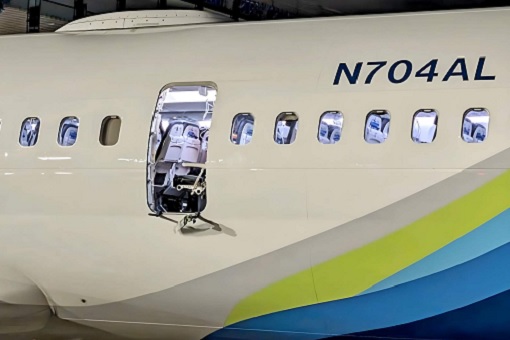
Exactly how the fuselage was blown off the Boeing airline remains a mystery, but the door plug was finally located and found in the backyard of a teacher in Portland. The FAA’s order will affect about 171 planes worldwide and applies to U.S. airlines and carriers operating in U.S. territory, leading to Alaska and United Airlines grounding their entire fleets of Boeing 737 Max 9s.
Also recovered were at least two passenger cell phones sucked out from the plane, apparently still working despite having plunged from 16,000 feet. Besides the phones and other unsecured personal property, the 171 passengers and six crewmembers on board should consider themselves lucky for not only escape death, but also suffered no serious injuries.
The tragedy could be fatal had the door plug detached from the plane at a higher altitude. At 16,000 feet, and still climbing, passengers and crew were still seated with seatbelts still on. It was also lucky that no one was seated in 26A and 26B, adjacent to where the door plug was located and blown off. The flight was only about 10 minutes from its departure airport – Portland International – when the panel detached at 6:38pm Friday.
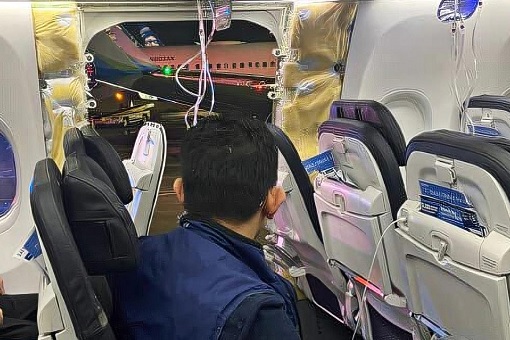
The only terrifying moment was when the passenger cabin was subject to explosive decompression. Anthony Brickhouse, a professor of aerospace safety at Embry-Riddle Aeronautical University, said such an incident is extremely rare. He said – “A gaping hole is not something we typically see. Rapid decompression is a serious matter. In aviation safety, we would call this a structural failure.”
Rapid or explosive decompression can result in hypoxia – oxygen starvation – which can cause dizziness, loss of consciousness or even permanent brain damage. The level where passengers would be safe without supplemental oxygen is 12,000 feet. Interestingly, the 737 Max 9 involved in the accident was “brand new” – delivered to Alaska Airlines on November 11.
While investigators from FAA and NTSB (National Transportation Safety Board) have started their investigations into the bizarre accident, the focus will be on how the door plug was fastened, as well as the plane’s air pressurization system. Investigators also will depend on photos and video from the time of the accident, not to mention clues from the recovered door plug.
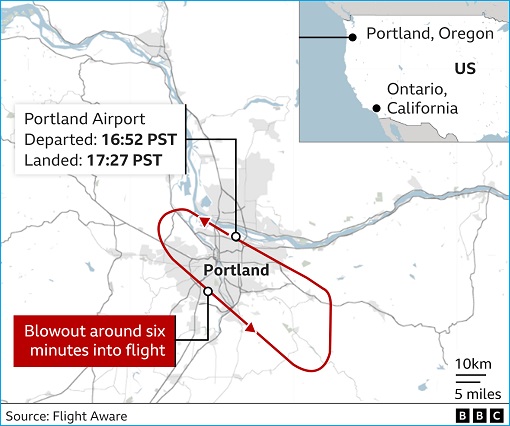
Essentially, Spirit AeroSystems, the company that installed door plugs into 737 fuselages at Spirit’s factory in Wichita, Kansas, would be scrutinized. As Boeing’s largest supplier for commercial planes and builds fuselages and other parts for Boeing Max jets, the company has been at the center of several recent problems with manufacturing quality on both the Max and a larger plane (Boeing 787 Dreamliner).
This could be the first case of its kind where a 25-kg exit door fell off. In the most horrific case previously, a flight attendant for Aloha Airlines was blown out of the cabin of a Boeing 737 over the Pacific Ocean in 1988 after an 18-foot-long (5.4-meter-long) chunk of the roof peeled away. Her body was never found. In 2009, a hole opened in the roof of a Southwest Boeing 737 flying 35,000 feet over West Virginia.
In those cases, the problems were blamed on metal fatigue in the plane’s aluminium skin. The latest accident could plague Boeing into a bigger crisis, after Boeing and Spirit AeroSystems discovered last year of improperly drilled fastener holes in a bulkhead that keeps 737 Max jets pressurized at cruising altitude. To make things complicated, Spirit uses multiple suppliers itself.
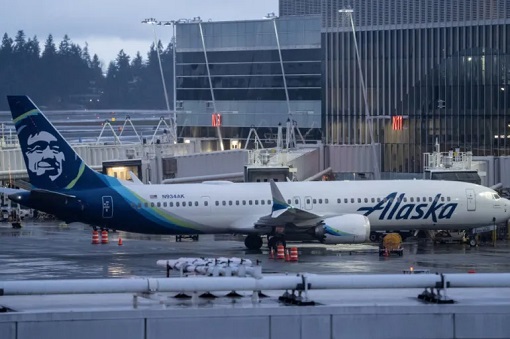
Whether it was due to cutting corners as a result of greed, or cursed, the Boeing 737 Max already suffered a crisis of confidence in 2019 after “two fatal crashes” within about five months of one another. After Indonesian budget airline Lion Air Flight 610 crashed on Oct 29, 2018, killing 189 people, a second crash involving Ethiopian Airlines Flight 302 on Mar 10, 2019 killed all 157 people on board (including passengers from 35 nations).
After an 18-month investigation into Boeing 737 MAX 8 deadly crashes – which killed 346 people in two accidents between 2018 and 2019 – the U.S. House of Representatives released its final report. The 238-page report from the House Committee on Transportation and Infrastructure basically confirmed what the public suspected – Boeing and FAA were responsible!
From the beginning, the 737 MAX – Boeing’s bestseller airplane – was produced with “serious flaws and missteps in the design, development, and certification of the aircraft.” Despite that, the 737 MAX aircraft – made at Boeing’s factory in the US state of Washington – received certification from the Federal Aviation Administration (FAA) in March 2017.
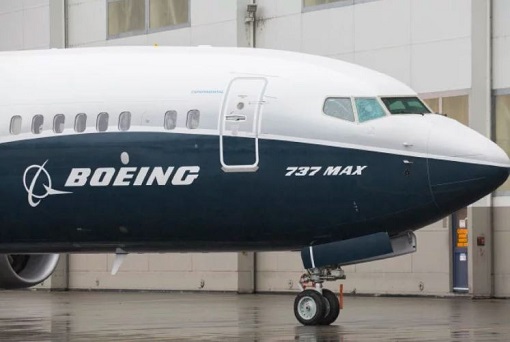
Investigators found that both crashes were tied to a software called the Maneuvering Characteristics Augmentation System (MCAS). In both crashes, incorrect data from a faulty sensor caused MCAS to misfire, forcing the plane to nose down repeatedly, even as the pilots struggled to regain control and gain altitude. Amazingly, MCAS was not mentioned in the pilot manual.
The new MCAS had been defective and problematic. To fit the Boeing MAX’s larger, 14% more fuel-efficient engines, Boeing had to redesign the way it mounts engines on the 737. This change disrupted the plane’s centre of gravity and caused the MAX to have a tendency to tip its nose upward during flight, increasing the likelihood of a stall.
The National Transportation Safety Board (NTSB) found that the pilots in both Indonesian and Ethiopian crashes were bombarded with multiple alarms and alerts in the cockpit before the planes crashed. The new design and system was so complex – and secretive – that some pilots said that they didn’t even know the MCAS system was on the plane (because Boeing tried to hide it).
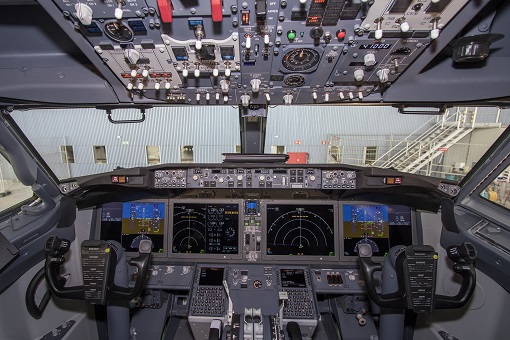
The committee report said it found damning evidence of “repeated and serious failures by both Boeing and the FAA” in 737 MAX aircrafts that killed 346 people. While Boeing was responsible for hiding “crucial information from the FAA, its customers, and 737 MAX pilots”, the FAA was faulted for giving Boeing so much leeway that led to the failure to report certain safety issues.
In fact, FAA officials had given Boeing approvals, overruling the agency’s own safety regulations just to keep Boeing happy. In December 2019, a document derived from the FAA’s November 2018 internal analysis was released during the House Transportation Committee hearing. That document revealed some very damaging information.
Not only did the Boeing engineers know about the defective MCAS software as early as 2017, but also the calculations of possible fatal crashes as a result of it. But the best part was that after the first crash involving the Lion Air flight in October 2018, an FAA analysis of the Boeing 737 MAX jetliner had predicted “as many as 15 future fatal crashes within the entire lifespan of the aircrafts”.
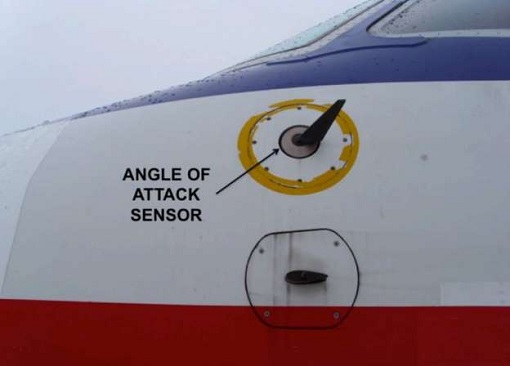
Despite the discovery by the FAA that the Boeing 737 MAX could crash 15 times and kill more than 3,000 people in its lifespan of 45 years, the FAA allowed the airplane to keep flying anyway. The committee final report has revealed the dirty secrets why Boeing was allowed to escape scrutiny from the FAA, so much so that both Boeing and FAA were scratching each other’s back.
Apparently, there was tremendous financial pressure on Boeing and the 737 MAX program to compete with Airbus’ new A320neo aircraft. Boeing had to deliver profits for Wall Street, leading to cost cutting measures and rushing to maintain the program on schedule. The committee exposed how Boeing and FAA both gambled with public safety in exchange for profits.
The report also revealed how Boeing’s “culture of concealment” created a situation where years before the crashes, a Boeing test pilot took more than 10 seconds to diagnose and respond to uncommanded MCAS activation in a flight simulator – a condition described as “catastrophic” because federal guidelines assume pilots will respond to this condition within 4 seconds.
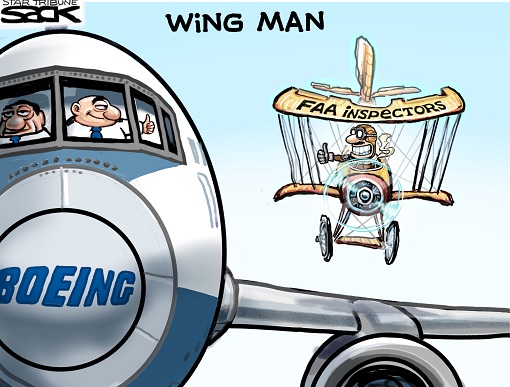
Boeing’s influence over FAA was so severe that not only Boeing employees have been authorized to perform work on behalf of the FAA, but also failed to alert the FAA to potential safety and/or certification issues. It was so bad that even FAA employees believed their senior leaders were more concerned with helping Boeing achieve its goals that safety-related decisions have been ignored.
The Committee Chair DeFazio said – “On behalf of the families of the victims of both crashes, as well as anyone who steps on a plane expecting to arrive at their destination safely, we are making this report public to put a spotlight not only on the broken safety culture at Boeing but also the gaps in the regulatory system at the FAA that allowed this fatally-flawed plane into service.”
There are 215 Boeing 737 Max 9 planes in service worldwide, including Aeromexico, Turkish Airlines, Icelandair and Panama’s Copa Airlines. Could the latest accident part of a series of manufacturing, if not design, flaws that would repeat again? Regardless whether Max-8 or Max-9, they are from the same MAX family. Last month, Boeing asked airlines to inspect its 737 Max jets for a potential loose bolt in the rudder control system.
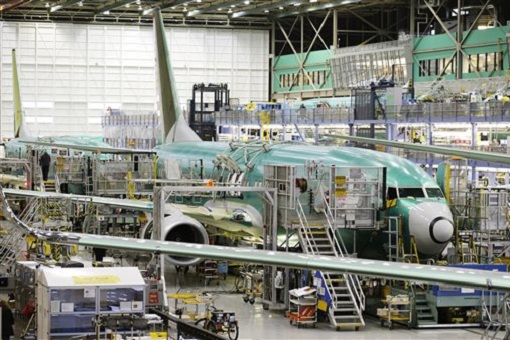
Other Articles That May Interest You …
- Committee Final Report – Boeing & FAA Responsible For Hiding Design Flaws In 737 MAX That Killed 346 People
- FAA Calculated Boeing 737 MAX Could Crash 15 Times & Kill More Than 3,000 People – But Allowed It To Keep Flying
- More Problems – Now Boeing Is Forced To Suspend Test For New 777X Aircraft After “Door Explosion”
- An Admission Of Guilt – Former Boeing Official Invokes Fifth Amendment Protection In 737 MAX Scandal
- Boeing 737 MAX Has “No Value” – Lawyer Says Public Doesn’t Trust It, Client Can’t Use It
- Zero New Orders For 737 MAX – Airbus To Overtake Boeing As World’s Biggest Plane Maker
- It’s Not Over Yet – Lawsuits Are Piling Up Against Boeing For Misleading Investors & Covering Up
- How China Uses The Purchase Of 300 Airbus Jets To Pressure Both European Union & The U.S.
- Profit-Hungry Boeing – Crashed 737 Max Jets Did Not Have 2 Safety Features Because They’re Optional
- FAA Protecting Boeing? – Despite Assurance, Airlines Around The World Suspend Boeing MAX-8 Jets
- Secret Revealed – The Secret Chambers Where Pilot & Cabin Crew Rest & Sleep (Photos)

|
|
January 8th, 2024 by financetwitter
|


|

|

|

|

|

|
Comments
Hey, why is a Malaysian part being blamed for the magic emergency door of the most recent Boeing to encounter yet another serious safety issue to do with to do with Boeing’s steady stream of aircraft disasters.
It is a cheap ploy to point any finger at Malaysia the mother country of technology and the home of the famous Proton car – which was a disaster in itself considering the crap origami coffin with four cheap tyres was a gigantic fcuking disaster that for some twenty years bled our coffers dry through every crap grotesque moronic genius you don’t want to think of.
Thankfully, the Allamighty sent the Chinese Uncles to the rescue, the moment the Chinese got the majority share of the crippled parasite Proton, a big miracle happened, the blessed Uncles turned Proton around and made it a gigantic success, like only the Chinese Uncles can. Overnight tens of thousands of Malaysians queue to buy and wait long months for the delivery of their slick Chinese Protons. Previously, those who had liked the “Mamakthir’s child” were the owners of garages doing the repair work.
If not for the Chinese buying over Proton, the old Proton would have gone sky’s the limit, made planes fall outa skies. Like it made the old Protons ugly coffins on the roads, contributing with patriotic fervour to Bolehland’s huge road deaths.
It may or may not be the Malaysian aircraft part that caused the frightening accident. The Yanks are good at shifting blame. But if the horrific incident was caused by our Proton-grade skill, I won’t be altogether surprised either.
Still, I’d blame Boeing first, they’ve been making crap quality aircraft and it’s not just the 737. All Boeing aircrafts across its range have been suffering from complaints. With the lack of confidence in Boeing, I would suggest Boeing sell itself off to the Chinese, and for manufacturing to be done in China. Parts can be done even in Bolehland, and even by Proton – but under very strict supervision by the Chinese.
Another good reason why it is necessary to sell Boeing off to the Chinese is the Chinese are coming up with great aircrafts themselves. With what the Chinese are like, it is a matter of a just a short time the Uncles conquer the skies with their aircrafts. If the Uncles stop buying Boeing aircrafts, Boeing will be pretty much buggered, Boeing’s CEO hinted as much. It’d be a “win-win” case for both, China wins a lot, Boeing wins a little. It would be better for Boeing than being dead.




























There were some incredible horror stories in their inspection of the assembly outfits when Boeing engineers were forced to do some serious work looking at works on their aircrafts, both new ones and maintenence and repair.
Among the most frightening discoveries, a ladder was found left inside the tail of an aircraft that had passed inspection. And electrical wires were found held together with chewing gum! Bolts were not tightened and rivets missed.
Seriously, Boeing should just close, it is dangerous to gamble on safety with lives, Boeing can still make plenty of money concentrating on producing weapons of slaughter and destruction.
Meanwhile, China has appeared on the horizon with two commercial aircrafts, the C919, and the C929, both very promising, and for the C919, around 1,000 aircrafts orders of around a thousand have already been signed. With their price tags, airlines around the world are showing great interest. And both Boeing and Airbus are nervous about the success of the Chinese aircrafts.
I say the greatest of success to the Chinese!